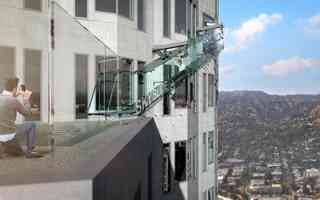If you’re afraid of heights, beware of this recent architectural trend. From London to Los Angeles, fully transparent glass floors are being constructed hundreds, sometimes thousands, of feet in the sky for visitors to fully experience the vista below. It’s certainly an interesting, if not slightly terrifying, development in architecture. “We all know people are fascinated and stimulated by heights,” says Tim Johnson, vice-chair of the Council on Tall Buildings and Urban Habitat. “Until recently, our perspective has been to view a landscape horizontally from a significant height. However, a trend is taking hold that people are thrilled to be suspended in mid-air, if you will.” Why glass floors? Johnson speculates that it's a new way for developers to make their projects stand out and to draw visitors to experience, "yet another breathtaking element of tall buildings." AD covers five examples around the globe that exemplify this new transparent trend in architecture.

Los Angeles's Glass Slide
Soon there will be an all-glass slide that extends from the 70th to the 69th floor of the U.S. Bank Tower in downtown Los Angeles. Visitors will glide down a 36-foot glass structure, dubbed the Skyslide, which is a mere 1.25 inches thick. The project is part of a larger $50 million renovation on the building and will open to the public in June.

London’s All-Glass Swimming Pool
In London, the architecture firm HAL is currently working with developer EcoWorld Ballymore on the 2,000-residence Embassy Gardens project, where two buildings will be linked by an all-glass swimming pool measuring 90 feet long, 19 feet wide, 10 feet deep, and suspended more than 100 feet above street level. The transparent pool, devised by the architecture firm Arup Associates, is expected to open in 2019.

A Dalí-Inspired Observation Deck in Norway
Each year, more than 200,000 travelers trek up to a steep cliff overlooking the Lysefjord valley in Norway. At 1,980 feet above sea level, the views from Preikestolen—or Pulpit Rock—are as dizzying as they are breathtaking. And to accommodate the spike in tourists, local experts have explored modern ways for creating an observation deck atop Pulpit Rock. German firm Fly Architecture recently submitted a proposal that resembled a massive melting eye—a design based on Salvador Dalí’s famous painting The Persistence of Memory (1931). Made of aluminum and glass, the structure would allow for multiple rows of stepped seating.
A Look Below London’s Tower Bridge
In December 2014, a transparent walkway on the upper crossing of London’s Tower Bridge opened, allowing visitors to look straight down at the traffic and pedestrians—not to mention the Thames—138 feet below. Made of clear panels weighing over 1,100 pounds each, the 36-foot-long glass floor was installed along both the east and west walkway.
China’s Record-Setting All-Glass Bridge
In 2015, the world’s tallest and longest glass-bottom bridge opened in China’s Zhangjiajie national park. Designed by Israeli architect Haim Dotan, the bridge spans 1,410 feet over a breathtaking 984-foot drop and offers panoramic views of the landscape. The Zhangjiajie bridge isn’t merely for tourism; it will serve as a runway for fashion shows, and it’ll be home to the world’s highest bungee jump as well.

Leave a Reply